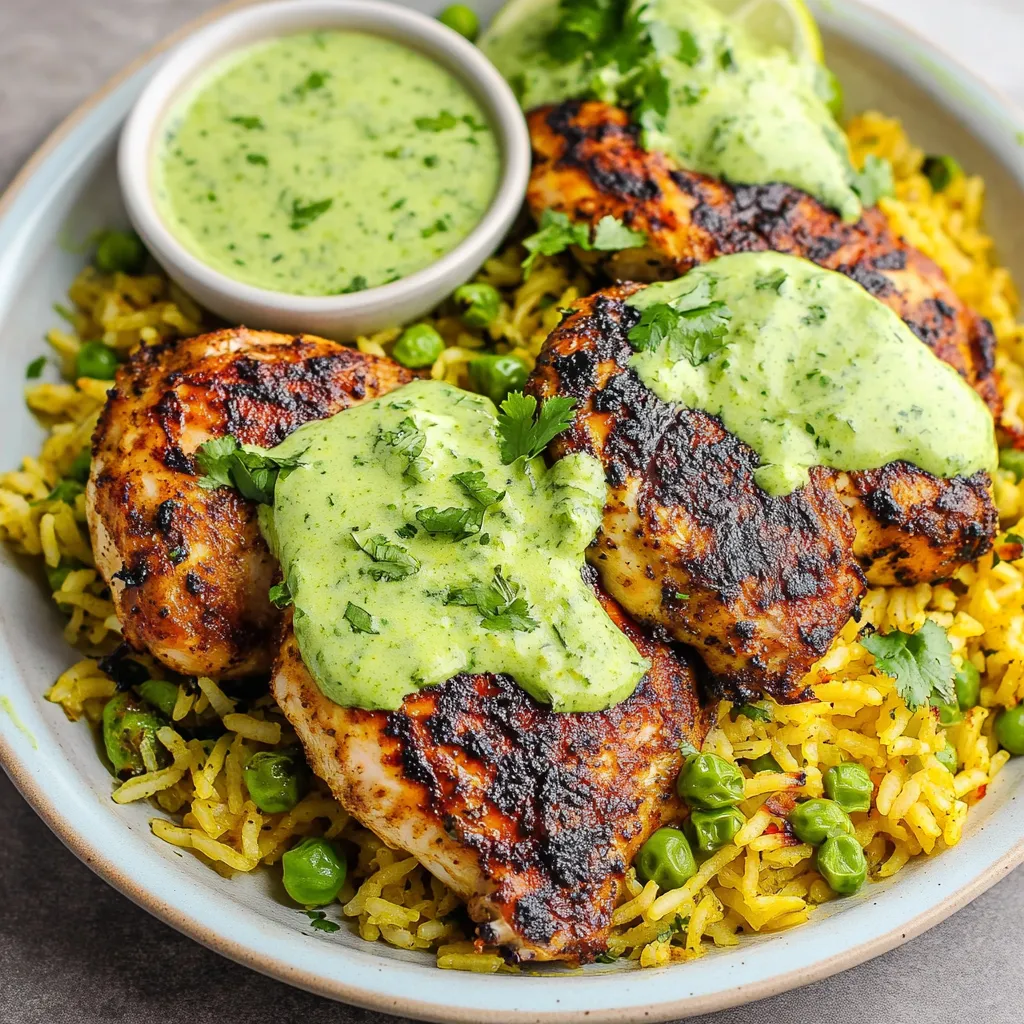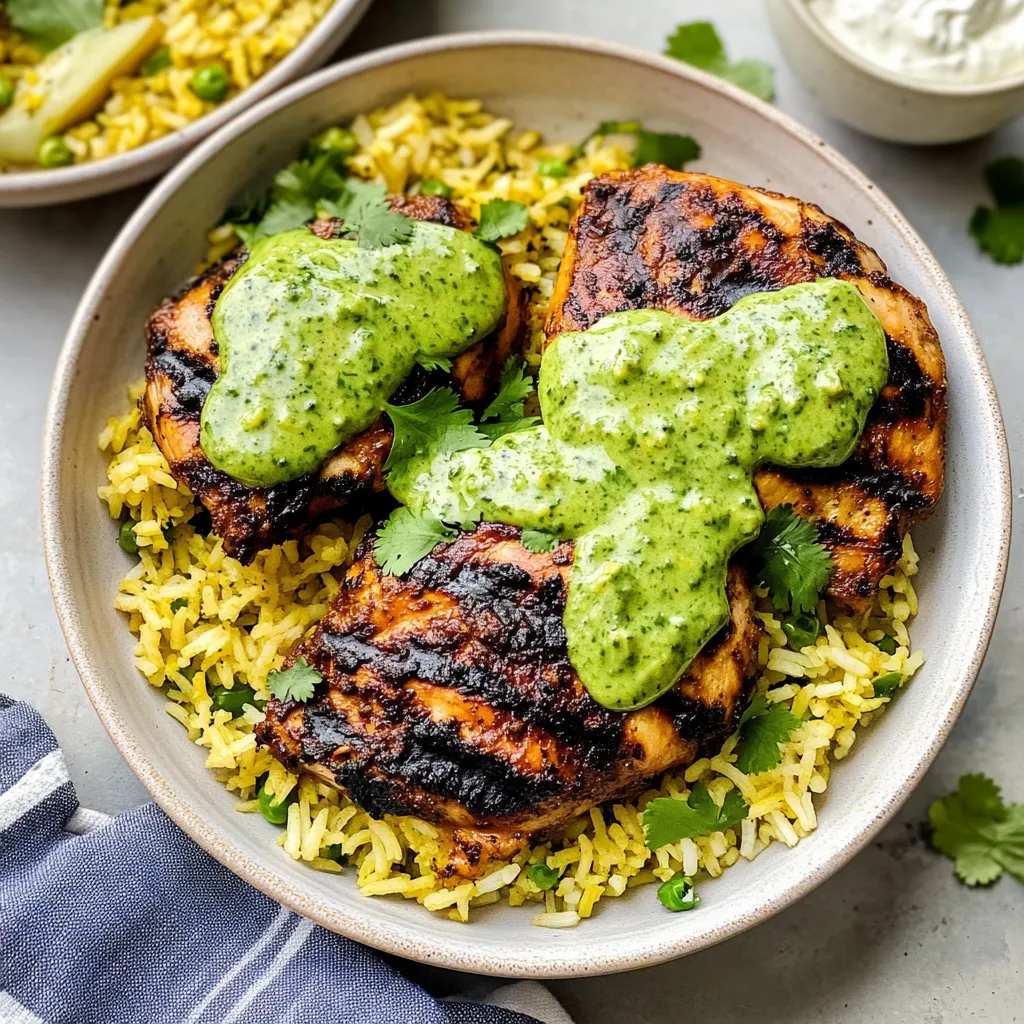 Pin
Pin
The soul of Peruvian gastronomy is encapsulated in this lively chicken and rice creation, where fragrant seasonings converge with verdant herbs and bright citrus notes. The combination of delicate, spiced chicken, brilliant yellow turmeric rice, and the characteristic verdant condiment yields a unified taste experience that delivers South American culinary traditions directly to your dining setting. Each element fulfills a vital function – the poultry infused with deep, earthy spices, the rice imparting a gentle warmth, and the condiment introducing a vibrant, velvety finish.
The prior week, our neighbors shared an evening meal with us, and this recipe initiated an engaging discourse regarding Peruvian cooking. The verdant condiment, specifically, became the prominent topic of discussion throughout the evening.
Essential Ingredients
- Chicken: Opt for premium quality portions possessing uniform thickness to ensure consistent cooking times
- Fresh Cilantro: Indispensable for achieving authentic verdant condiment flavor
- Turmeric: Imparts the rice's distinctive golden hue and deep, earthy flavor profile
- Jalapeños: Modify quantity based on desired level of spiciness
- Quality Stock: Elevates the rice with a more pronounced and complex flavor
My initial endeavor with this recipe illustrated to me that using fresh botanicals and adhering to appropriate marinating durations are paramount in attaining genuine Peruvian taste nuances.
Detailed Instructions
- 1. Chicken Preparation:
- Commence by blending finely chopped garlic, lime essence, oil, and seasonings within a mixing bowl. The marinade should possess sufficient density to uniformly enrobe the chicken pieces. Set aside a fraction for subsequent basting purposes – this assures culinary safety while concurrently enriching flavor during thermal processing. Thoroughly massage the marinade onto the chicken, guaranteeing comprehensive coverage of each segment. Allow it to rest under refrigeration, enabling the acidic components and spices to tenderize the protein.
- 2. Rice Development:
- Initiate by rinsing rice until the drained liquid becomes transparent – this action eliminates surplus starch, promoting a more airy final texture. The sautéing procedure is indispensable – permit onions to transition to translucence and garlic to emit fragrance prior to rice introduction. This phase builds a foundational flavor base. Briefly toast rice alongside spices to unleash their full aromatic potential. Introduction of heated stock assists in preserving consistent cooking temperature for uniform outcomes.
- 3. Sauce Creation:
- Utilization of fresh cilantro is non-negotiable for genuine flavor authenticity. Group cilantro loosely when quantifying – dense packing can skew intended proportions. Commence with milder jalapeño varieties, incrementally increasing heat to match personal taste. The mayonnaise-sour cream substrate necessitates exhaustive blending to achieve optimal smoothness. Season judiciously at the outset – flavor profiles deepen as the condiment rests.
- 4. Final Assembly:
- Stratify components thoughtfully – initiate with a foundation of rice, permitting its fragrant steam to gently warm the serving plate. Position chicken segments at an incline to enhance visual presentation. Disperse verdant condiment in a decorative manner rather than consolidating it in a single pool. The condiment should enhance, not dominate, the overall flavor. Garnish with additional cilantro sprigs and lime sections for both aesthetic appeal and to introduce supplemental fresh flavor as preferred.
- 5. Temperature Management:
- Scrupulously monitor chicken internal temperature – overcooking can lead to desiccation. For rice, sustain a consistent low heat application throughout the cooking duration. Post pea introduction, allow it to rest, enveloped under cover – this concluding steaming phase ensures ideal texture attainment. Dispense verdant condiment at ambient temperature to facilitate optimal flavor release.

Years of preparing this recipe have imparted to me that success is rooted in respecting each singular component, alongside comprehending their synergistic interactions. Irrespective of whether grilled over open flames or baked during colder periods, this Peruvian chicken delivers both comfort and exhilaration in each portion dispensed.

Serving Suggestions
Peruvian chicken merits deliberate presentation to maximize its sensory impact. Arrange the golden-hued rice within a refined mound utilizing a culinary ring or measuring cup, subsequently positioning the chicken atop at a slight inclination to generate vertical interest. Artistically drizzle the vivid verdant condiment in a patterned fashion, culminating with fresh micro-cilantro or finely chopped herbs. Present alongside lime segments, sliced avocados, and supplementary verdant condiment provided on the side. For family-style dining, present constituent elements separately: a platter showcasing sliced chicken, a tureen of steaming rice, and the condiment contained within a decorative serving vessel. This arrangement empowers diners to personalize portion sizes while preserving ideal serving temperatures.
Seasonal Adaptations
Summer months beckon for flame-grilled chicken, imbued with smoky notes and accompanied by a lighter quinoa alternative to rice. Incorporate flame-grilled corn kernels and a vibrant fresh tomato salad to embrace seasonal freshness. During winter periods, oven-bake the chicken for a comforting repast, potentially augmenting the plate with roasted root vegetables. Springtime heralds verdant herbs – contemplate introducing mint to the verdant condiment and serving alongside asparagus spears. An autumnal variation might encompass roasted butternut squash integrated within the rice base, alongside warming spices such as cinnamon incorporated into the marinade blend. Each distinct season presents prospects to refine the foundational recipe whilst upholding its quintessential Peruvian character.
Perfect Pairings
Enhance this culinary creation with time-honored Peruvian accompaniments, such as buttery sweet corn kernels or crisp yuca fries. A straightforward salad of cucumber and red onion, dressed with lime juice, offers a counterpoint to the dish's inherent richness. For beverage selections, contemplate a citrus-forward Pisco Sour cocktail or a chilled Chilean white varietal. A suitable concluding sweet course might be alfajores – delicate sandwich-style biscuits filled with dulce de leche caramel – or refreshing fresh mango sorbet. The pivotal aspect is achieving a harmonious equilibrium of tastes and textures throughout the entire meal progression. Lighter appetizers, exemplified by ceviche, serve to prepare the palate, while abstaining from overly rich side dishes which risk overpowering the central course.

My progression with this Peruvian chicken recipe serves as a reminder that exceptional cooking emerges from an appreciation of not solely the constituent elements, but additionally their cultural import. The fusion of seasonings, the meticulous method applied to each component's preparation, and the concluding assembly sequence all mirror Peru's abundant culinary legacy. With each successive instance of preparing this dish, I unveil novel subtleties in flavor and culinary techniques.
Final Thoughts
These Peruvian flavor profiles have transitioned into a valued segment of my culinary repertoire, conveying significant insights into harmonizing spices and honoring established culinary practices.
Recipe FAQs
- → Can I make this ahead of time?
- Yes! Marinate chicken overnight and make green sauce up to 2 days ahead. Rice is best made fresh.
- → What's the best chicken cut to use?
- Chicken thighs are traditional and stay juiciest, but breasts, drumsticks, or even a whole chicken work well too.
- → Is the green sauce very spicy?
- The heat level is adjustable. Remove jalapeño seeds for milder sauce, or use less jalapeño.
- → Can I freeze leftovers?
- Chicken and rice freeze well separately. Green sauce is best fresh but can be refrigerated for 3-4 days.
- → What can I substitute for cilantro?
- While cilantro is traditional, you can use parsley for a different but still delicious green sauce.
